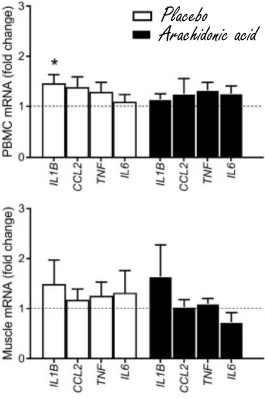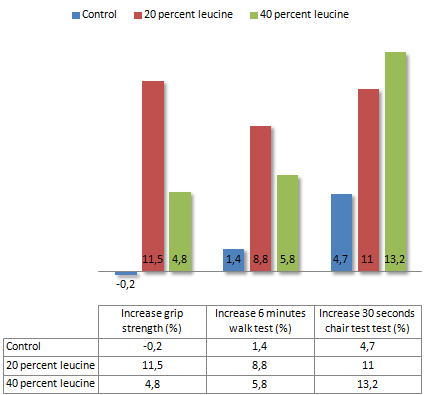|
Arachidonic acid, a muscle-strengthening fatty acid without health risks
According to a small but growing number of human studies, supplementation with one and a half grams of arachidonic acid per day stimulates muscle growth. But is arachidonic acid safe in those quantities? Doesn't the stuff also trigger inflammatory reactions in the body? According to a small human study that sports scientist James Markworth, from the University of Auckland in New Zealand, published in Prostaglandins, Leukotrienes & Essential Fatty Acids, there is no cause for concern.
Arachidonic acid
Every day the average Westerner consumes about 15 grams of the omega-6 fatty acid linoleic acid. Using this linoleic acid as a precursor, the body synthesizes about 30 milligrams of arachidonic acid, another omega-6 fatty acid daily. Through diet the same average Westerner consumes about 150 milligrams of arachidonic acid daily.
The bulk of the arachidonic acid in the human body - of which a surprisingly high percentage can be found in muscle tissue - is not synthesized from linoleic acid, but comes directly from the diet. This suggests that supplementation with arachidonic acid is an excellent way to increase the amount of arachidonic acid in the muscles.
More arachidonic acid in the muscles means more muscle growth according to studies. Arachidonic acid is the precursor of all kinds of inflammatory factors, such as PGFs and PGEs. Some of them play a crucial role in muscle growth. That was the reason behind the introduction of arachidonic acid as a sports supplement by Molecular Nutrition over a decade ago.
But, as some nutrition scientists ask themselves, is supplementation with such amounts of arachidonic acid safe? Indeed, inflammatory factors can also have negative health effects. Hence the New Zealand research.
Study
Markworth divided 19 male twenties, all of whom had been training with weights for at least a year, into two groups. One got 1500 milligrams of arachidonic acid daily for 4 weeks, the other group took a placebo. The researchers used Arasco, a DSM product. Arasco is mainly used in baby food.
The research was by no means funded by Molecular Nutrition, nor by DSM.
Results
Supplementation with arachidonic acid did not lead to statistically significant changes in body composition - but well, the duration of the study was too short for that. However, the supplementation improved the cholesterol household of the test subjects a bit.
During the supplementation period, the concentration of arachidonic acid in white blood cells [PBMC] and muscle cells increased by 8 and 4 percent respectively. Nevertheless, the production of inflammatory factors such as interleukin 1-beta and TNF-alpha did not increase - not in the blood cells and not in the muscle cells.


Supplementation with arachidonic acid increased the production of MyoG and MyoD1 in the muscle cells. These are signaling molecules that play a role in muscle growth, partly because they make stem cells to develop into new muscle cells.
Conclusion
"Increasing arachidonic acid consumption by 1.5 g/day arachidonic acid for 4-weeks in healthy young men participating in resistance exercise training promotes greater changes in plasma and muscle lipid arachidonic acid abundance compared to placebo, but this is not associated with any evidence of a heightened systemic or intramuscular basal inflammation", Markworth wrote.
"Arachidonic acid supplementation also had no obvious negative impact on a range of clinical parameters in this population. Therefore, short term increases in dietary arachidonic acid intake at least up to 1.5 g/day do not influence local inflammation in healthy young men participating in regular resistance exercise training."
Source:
Prostaglandins Leukot Essent Fatty Acids. 2018;128:74-86.
More:
Arachidonic acid boosts anabolic stimulus of strength training 16.08.2016
Daily 1500 mg arachidonic acid makes strength athletes stronger and bulkier 25.07.2014
Cell study: more arachidonic acid, more muscle growth 11.04.2013
Archives:
Arachidonic Acid
|







